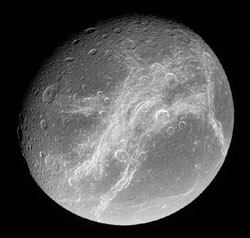
Saturn's moon Dione, as captured in polarized green light by the Cassini orbiter on July 24, 2006, from a distance of 263,000 kilometers (163,000 miles). Details as small as 2 km can be discerned on the 1,126-km-wide moon. Click on image for a larger view.
Kelly Beatty
One of the Cassini mission's early revelations was Enceladus's atmosphere, initially detected around the icy moon by the craft's magnetometer. Soon thereafter, by looking on as Enceladus occulted a star, Cassini's Ultraviolet Imaging Spectrometer (UVIS) confirmed the magnetometer's findings. Eventually geysers were seen, an astounding discovery that flew in the face of expectations.
Here we go again.
This time the moon is Dione. In two presentations given this week at the Lunar and Planetary Science Conference in Houston, Texas, researchers made a case for active outgassing on this midsize icy world. First, Jeff Moore (NASA/Ames Research Center) and Paul Schenk (Lunar and Planetary Institute) described evidence in Cassini images for volcanic flows on Dione's surface. Then Jared Leisner (UCLA) announced that Cassini's magnetometer had sensed a tenuous cloud of material surrounding Dione as the spacecraft flew past it.
Leisner estimates that Dione sheds just 650 grams of material per second into space — far less than the 300 kilograms per second spewed by Enceladus, but far greater than the 40 grams per second that would be expected if Dione were completely inert. Tethys, another Saturnian moon that Moore says shows volcanic flow features, has no detectable outgassing at all.
However, confirming Dione's gas release with another instrument has proven difficult. According to Amanda Hendrix (Jet Propulsion Laboratory), images of Dione taken at high phase angles — the same viewing geometry that revealed Enceladus's geysers — came up empty. Apparently there's too little dust entrained in the escaping gas (or too little ejecta, period) for Cassini's cameras to see it.
So the confirmation task now falls to the UVIS instrument. As with Enceladus, a stellar occultation should allow mission scientists to detect the spectral signature of the material coming off Dione. Sometime within the next few months, says team member Candice Hansen (Jet Propulsion Laboratory), Cassini will watch carefully as Dione occults a star.
Assuming that the outgassed material is detected, UVIS will likely discover that it's mostly water, as is the case with Enceladus. Seeing Dione's atmosphere with UVIS is a long shot, Hendrix admits, but "it's worth trying."
 0
0
Comments
You must be logged in to post a comment.